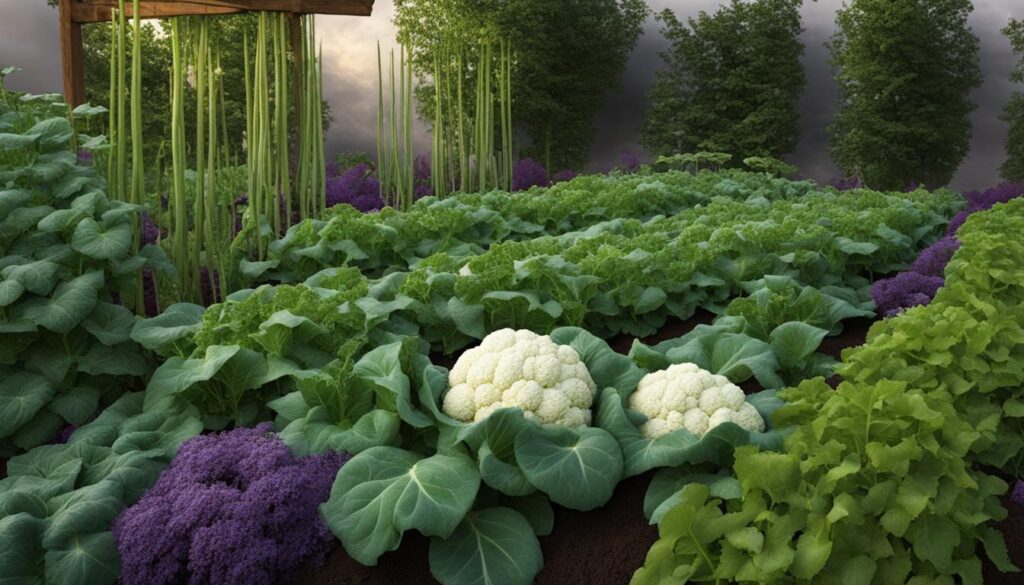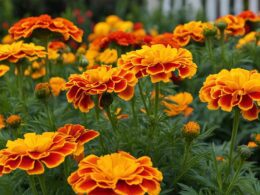Companion planting is a gardening technique that involves growing two or more plant species together for their mutual benefit. When it comes to growing cauliflower and beans together, they can enhance each other’s growth and provide numerous benefits. Beans are nitrogen fixers, which means they add nitrogen to the soil, benefiting the nitrogen-hungry cauliflower. In return, cauliflower can help protect the roots of beans and improve soil structure. Companion planting cauliflower and beans can also help deter pests that commonly affect cauliflower, such as aphids and Japanese beetles.
Post Summary:- Growing cauliflower and beans together promotes mutual benefits and enhances growth.
- Beans add nitrogen to the soil, benefiting nitrogen-hungry cauliflower.
- Cauliflower protects bean roots and improves soil structure.
- Companion planting helps deter pests that affect cauliflower.
Choosing the Right Companion Plants for Cauliflower
When it comes to companion planting cauliflower, selecting the right companion plants can greatly enhance their growth and overall health. Certain plants have beneficial properties that can create a harmonious environment for cauliflower to thrive. Here are some excellent companion plants that grow well with cauliflower:
- Beans: Beans are an ideal companion for cauliflower as they are nitrogen fixers. They enrich the soil with nitrogen, which is essential for the growth of nitrogen-hungry cauliflower.
- Celery: Planting celery alongside cauliflower can attract beneficial insects and provide shade, which helps conserve moisture for both plants.
- Onions: Onions repel pests that commonly affect cauliflower, such as aphids and cabbage worms. Planting onions nearby can help protect your cauliflower crop.
- Sage and Thyme: These herbs not only add flavor to your dishes but also have pest-repellent properties. They can deter pests that commonly affect cauliflower and attract pollinators to promote healthier plants.
By strategically choosing these companion plants, you can create a diverse and balanced garden ecosystem that benefits your cauliflower crop. The interplay between these plants can improve soil quality, deter pests, and enhance the overall growth of your cauliflower plants.

It’s important to note that while these plants make excellent companions for cauliflower, there are certain plants that should be avoided. Avoid planting cauliflower near crops such as potatoes, strawberries, and tomatoes, as they can be susceptible to similar pests and diseases.
Companion Plants for Cauliflower
| Companion Plants | Benefits |
|---|---|
| Beans | Nitrogen fixation, improved soil fertility |
| Celery | Attracts beneficial insects, conserves moisture |
| Onions | Repels pests that affect cauliflower |
| Sage and Thyme | Pest-repellent, attracts pollinators |
By choosing the right companion plants for cauliflower, you can create a synergistic garden that promotes the health and productivity of your cauliflower crop. Consider these companion plants when planning your garden to maximize the benefits for your cauliflower plants.
Planting and Growing Cauliflower and Beans Together
Planting cauliflower and beans together can be a rewarding and beneficial gardening practice. Not only do these two plants complement each other in terms of growth and soil health, but they also deter pests and provide a bountiful harvest. By following a few simple steps, you can successfully grow cauliflower and beans together in your garden.
Preparing the Soil
Before planting cauliflower and beans, it’s important to prepare the soil properly. Start by clearing the area of any weeds or debris. Then, amend the soil with compost or well-rotted manure to enrich it with essential nutrients. This will provide a fertile foundation for both plants to thrive.
Proper Plant Spacing
When planting cauliflower and beans together, it’s crucial to consider their spacing requirements. Cauliflower plants should be spaced around 18-24 inches apart to allow enough room for their heads to develop fully. Bean plants, on the other hand, can be spaced 6-12 inches apart. This spacing ensures that each plant has enough space to grow and receive adequate sunlight and nutrients.
Watering and Fertilizing
Regular watering is essential for the healthy growth of cauliflower and beans. Keep the soil consistently moist but not waterlogged. It’s also important to fertilize the plants every few weeks, especially with a high-nitrogen fertilizer for cauliflower. This will help promote lush foliage and robust growth. Additionally, consider staking the bean plants if necessary to provide support.

Pest Control
Companion planting cauliflower and beans can help deter pests that commonly affect cauliflower, such as aphids and Japanese beetles. However, it’s still important to monitor the plants for any signs of pest infestations. If you notice any pests, take appropriate measures to control them, such as using organic pest control methods or introducing beneficial insects to the garden.
By following these planting and growing tips, you can create a harmonious and productive garden by growing cauliflower and beans together. Enjoy the benefits of improved soil health, enhanced growth, and a plentiful harvest from your garden.
Harvesting and Maintenance Tips
Once your cauliflower and bean plants have matured and thrived, it’s time to reap the rewards of your hard work. Here are some harvesting tips to ensure you gather your cauliflower and beans at the right time:
- Harvesting Cauliflower:
- Harvesting Beans:
When the cauliflower heads are fully mature but still tight and white, it’s time to harvest them. Use a sharp knife to cut the heads off at the base of the plant. Be careful not to damage any neighboring plants or the roots of the cauliflower.
Beans should be harvested when they are young and tender, usually around 60 days after planting. Snap them off the plant gently to avoid damaging the rest of the plant. Harvest beans regularly to promote continuous growth and a bountiful harvest.
After harvesting, it’s important to provide regular maintenance to ensure the ongoing health and productivity of your cauliflower and bean plants. Here are some maintenance tips to keep in mind:
- Watering:
- Fertilizing:
- Pest and Disease Control:
- Weed Management:
Water your plants according to their needs. Cauliflower plants require regular watering to maintain consistent moisture levels. Beans also need adequate watering, especially during dry spells, to prevent the pods from becoming tough and fibrous.
Regularly fertilize your plants to provide them with the necessary nutrients. Use a balanced fertilizer or a high-nitrogen fertilizer for cauliflower to support healthy growth. Follow the instructions on the fertilizer packaging for best results.
Monitor your plants for any signs of pests or diseases. Aphids and Japanese beetles are common pests that can affect cauliflower. Use appropriate insecticides or organic pest control methods to combat infestations. Remove any diseased plants or leaves promptly to prevent the spread of disease.
Regularly remove weeds that may compete with your plants for nutrients and sunlight. Weeds can hinder the growth and health of your cauliflower and bean plants, so it’s important to stay on top of weed control.
By following these harvesting and maintenance tips, you can ensure a successful and rewarding experience growing cauliflower and beans together. Remember to observe your plants closely and make any necessary adjustments to optimize their growth and productivity.
| Harvesting and Maintenance Tips |
|---|
| Harvesting Cauliflower |
| When the cauliflower heads are fully mature but still tight and white, use a sharp knife to cut them off at the base of the plant. |
| Harvesting Beans |
| Harvest beans when they are young and tender by snapping them off the plant gently. |
| Maintenance Tips |
| Water your plants according to their needs, fertilize them regularly, monitor for pests and diseases, and manage weeds to ensure optimal growth. |
Can I Grow Squash and Beans Together Like I Can Grow Cauliflower and Beans Together?
Growing squash and beans together can be an ideal combination just like growing cauliflower and beans together. This intercropping technique not only maximizes the use of space but also enhances crop productivity. While the squash’s spreading vines provide shade and weed suppression, the beans help in nitrogen fixation, benefiting both plants. This harmonious coexistence benefits the garden and the gardener alike.
Conclusion
Companion planting cauliflower and beans can be a beneficial gardening strategy that promotes the overall health and productivity of both plants. By choosing the right companion plants, preparing the soil adequately, and providing proper care, you can successfully grow cauliflower and beans together.
This companion planting technique can enhance the growth of cauliflower, improve soil quality, deter pests, and provide a bountiful harvest. The nitrogen-fixing properties of beans benefit the nitrogen-hungry cauliflower, while cauliflower plants can help protect the roots of beans and improve soil structure. Additionally, companion plants like onions, sage, and thyme can help deter pests and attract pollinators for a thriving garden.
Experiment with different companion plants in your garden and observe the positive interactions between cauliflower and beans. Discover the benefits of this gardening technique firsthand as you enjoy the rewards of healthy and thriving plants. With proper care and attention, you’ll have a successful vegetable garden filled with abundant cauliflower and beans.
So, get ready to experience the beauty of companion planting and witness the remarkable effects it has on your garden. Start growing cauliflower and beans together and reap the benefits of this harmonious gardening practice. Happy gardening!
Can I Grow Beans with Broccoli and Cauliflower Together in the Same Garden?
Yes, you can consider growing broccoli and cauliflower together in your garden. These plants are both part of the same family, known as cole crops, and have similar growing requirements. Planting them together can save space and improve the overall health of your garden. Just be sure to provide them with proper care.
FAQ
How can companion planting benefit the growth of cauliflower and beans?
Companion planting involves growing two or more plant species together for their mutual benefit. When growing cauliflower and beans together, beans add nitrogen to the soil, which benefits nitrogen-hungry cauliflower. In return, cauliflower can help protect the roots of beans and improve soil structure. Companion planting can also deter pests that commonly affect cauliflower.
What are some good companion plants for cauliflower?
Excellent companion plants for cauliflower include beans, celery, onions, sage, thyme, and dill. Beans enrich the soil with nitrogen, benefiting cauliflower’s growth. Celery attracts beneficial insects and shares water resources with cauliflower. Onions repel pests that commonly affect cauliflower. Sage and thyme deter pests and attract pollinators to promote the overall health of cauliflower plants.
How do I successfully grow cauliflower and beans together?
To grow cauliflower and beans together, start by preparing the soil with compost or manure. Space the plants adequately, and water them regularly. Fertilize the plants every few weeks, especially with a high-nitrogen fertilizer for cauliflower. Stake the beans if necessary and monitor the plants for pests. Take appropriate measures to control infestations. Harvest cauliflower when the heads are mature, and beans when they are young and tender.
How do I harvest cauliflower and beans?
For cauliflower, harvest the heads when they are fully mature but still tight and white. Cut the heads off at the base of the plant with a sharp knife. Store cauliflower in a cool, dark place for up to two weeks. For beans, harvest them when they are young and tender by snapping them off the plant. Start harvesting beans around 60 days after planting.
What maintenance is needed for cauliflower and beans?
Provide regular maintenance by watering the plants according to their needs, fertilizing them as required, and monitoring for pests or diseases. Remove any weeds that may compete with the plants for nutrients and sunlight.









